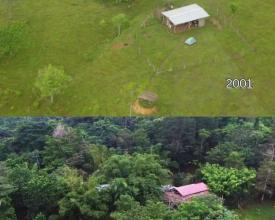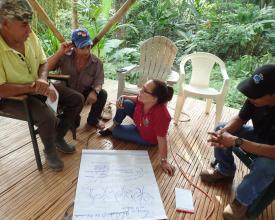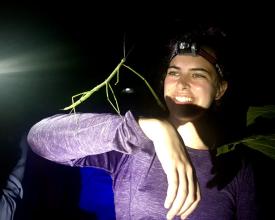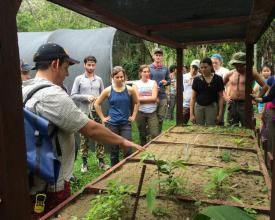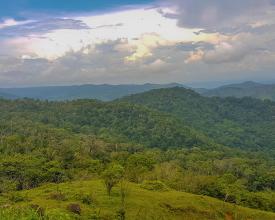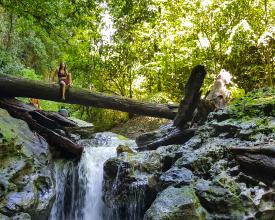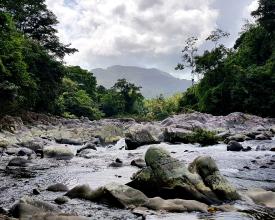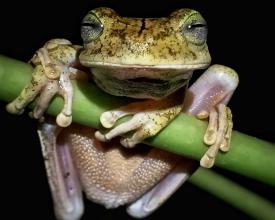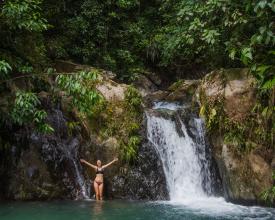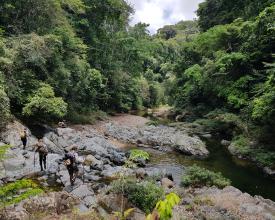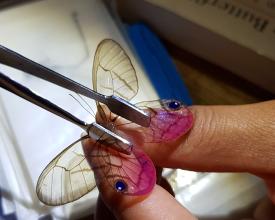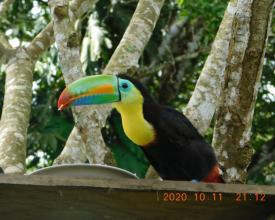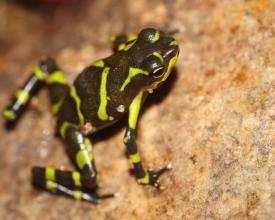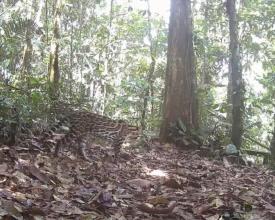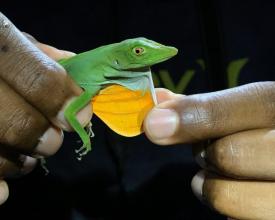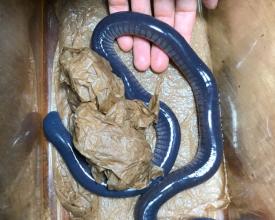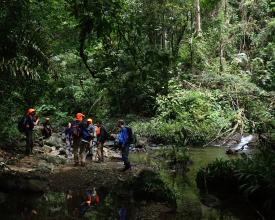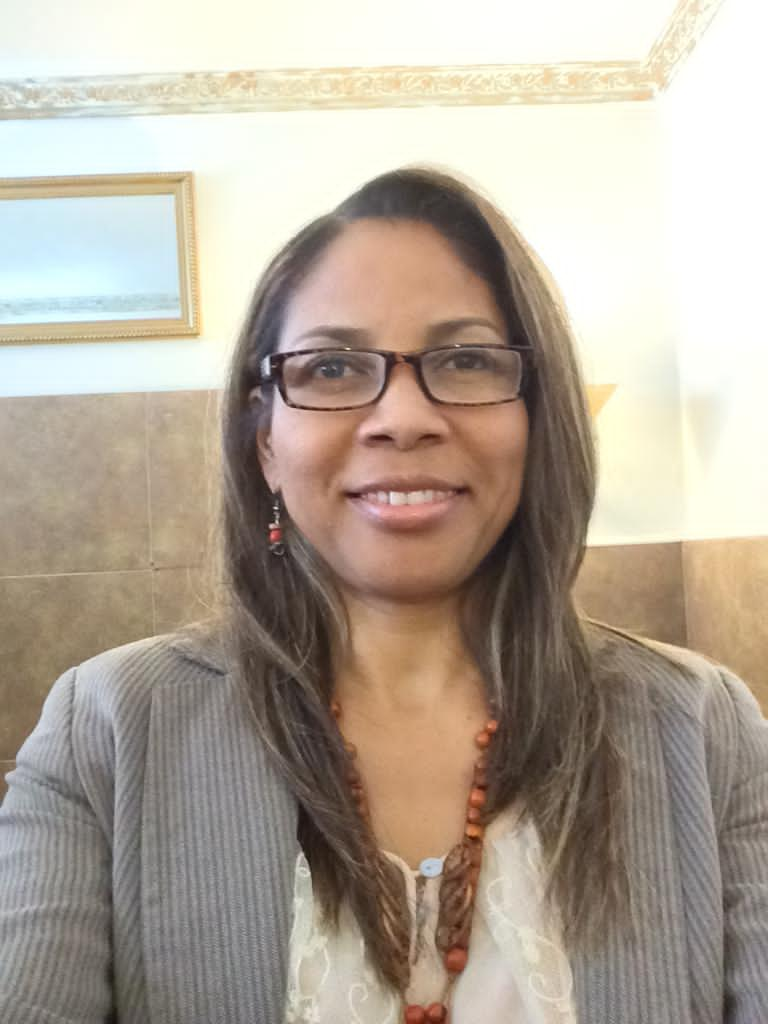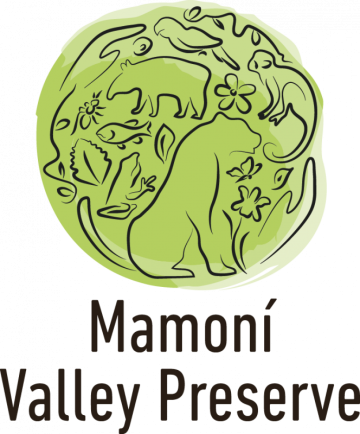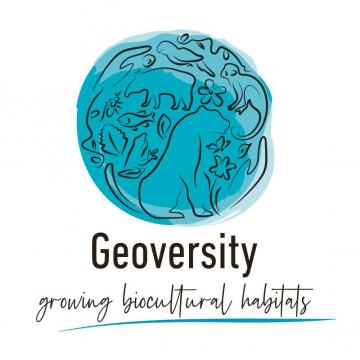
Mamoní Valley Reserve, a model of conservation and sustainability
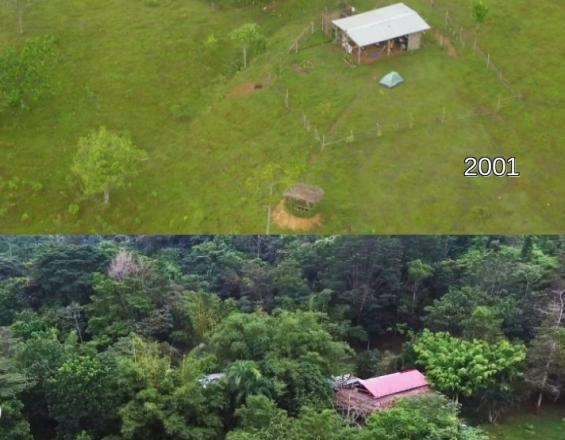
Located in an economically and ecologically vulnerable area (Madroño, Chepo), the Mamoní Valley Reserve with the Mamoní Center is the ideal setting for the preparation of students and young professionals in the area of sustainable economic and social development.
The project area is located within the largest remaining contiguous tropical rainforest in the exceptionally biodiverse Tumbes-Chocó-Magdalena ecoregion. It borders the Gunayala indigenous territory, Emberá communities, and the protected areas of Narganá and Chagres National Park.
We have reforested 132 hectares and have influenced the restoration of 600 hectares, in addition to the 100,000 trees planted by Geoversity in previous years.
We have experienced a 0.5% annual increase in forest cover.
We promote community participation through workshops, training on different topics and environmental education.
Context
Challenges addressed
- Promote a culture of love and protection of nature and all its ecosystems.
- Decrease poaching and indiscriminate logging.
- Increase the visitation of scientists, students and nature lovers.
- As of March 2020 COVID-19 has impacted all countries, our solution helps overcome the COVID-19 challenge both health wise and economically: By protecting the headwaters of the Mamoni River our neighbors can count on clean water important resource to comply with one of the biosecurity measure, constant hand washing, and thus prevent the growth of contagions. In addition, the neighbors can use the clean water for their agricultural activity, which is the basis for maintaining food security.
Location
Process
Summary of the process
The 3 BBs work in a parallel and integrated manner. In order to fulfill the solution, we must work with the communities to promote a culture of protection of nature and all of its ecosystems. Raising awareness in the neighboring communities will help us to conserve and protect our forest in the Mamoní Valley Reserve. As the forest is conserved we can work with researchers and scientists to develop studies of the different species that inhabit the reserve and finally, as we have conserved the area and developed several environmental education programs and scientific research we work hand in hand with several strategic allies to continue our work of education and preservation.
Building Blocks
Conservation Management
This solution combines several actions:
- Preservation and conservation in an integral manner the biota and other natural attributes existing in the Mamoní Valley Reserve, without direct human interference or environmental modifications.
- Recovery of altered ecosystems and the necessary management actions to recover and preserve the natural balance, biological diversity and ecological processes.
- Protection and monitoring of the area using SMART equipment, GPS and drones with the help of strategic allies.
- Collective work is a fundamental principle in this solution since we depend on all the actors to achieve the objectives. Due to this support work we have been able to map the forest cover of the reserve and detect deforestation.
Enabling factors
- We protect 5,000 hectares of biodiverse terrestrial and aquatic ecosystems.
- The solution is contributing to sequestering 650,000 tons of carbon.
- The roots of the trees we conserve and protect prevent landslides.
- The solution protects the headwaters of the Mamoní River, Chepo's main tributary.
- The solution ensures the protection of the biodiversity of the Tumbes-Chocó-Magdalena ecoregion.
- The reserve has 14 species of felines (melanistic jaguar), tapir, and the king gallinule, among others, some of which are endangered species.
Lesson learned
- The good relationship we maintain with the environmental authorities in Panama has given us recognition as a conservation organization and for two consecutive years we have received the Environmental Excellence Awards.
- The organization's committed work team has allowed us to achieve many accomplishments both locally and internationally.
- Having strategic allies that since 1990 have been helping the organization both financially and professionally has contributed to the development of many of our conservation initiatives and leadership programs.
- Environmental education in the communities is crucial as it will allow them to understand the value of forest conservation, develop the link with Mother Earth and perform sustainable actions with the environment.
Resources
Leadership and Research Management
This management has two components:
- The Leadership component: aimed at young emerging leaders with a desire to be active agents in the creation of sustainable communities.
- The research component: aimed at scientists and students who wish to use the Mamoní Valley Reserve as a living laboratory for their scientific research.
- The leadership component works with calls for young people to participate in the different programs that we develop both in the reserve and in urban forests, and the research component works with collaboration agreements with universities and scientific institutions.
Enabling factors
Favorable factors of this BB:
-
Collaboration agreements with: Biomundi (species study), Kaminando (feline studies) and we allow STRI to conduct harlequin frog re-introduction studies.
-
We have the dual "LifeChanger" program of nature immersion but also leadership.
-
We have a land area of 5,000 ha and the annual increase in forest cover is 0.5%.
-
In 2020 we are launching the Biocultural Leadership School, an initiative that seeks to train young environmental leaders.
Lesson learned
- The importance of allowing researchers, students and scientists to carry out their studies in the Mamoní Valley Reserve has an impact not only for them but also for the country and the world. For example, if the Smithsonian Tropical Institute discovers the reason why the fungus affects frogs in one geographic area and not in others, it could be decisive in saving a species.
- Achieving this combination of youth and mentor is a management strategy that contributes to create that critical mass to form young emerging leaders and protectors of the environment. At the beginning of the solution, a lot of manpower was required to build the structures of what would become the Mamoní Center, collaborators, volunteers and the executive team worked shoulder to shoulder.
- Creating a center or a conserved area is hard work that requires a lot of commitment and collective work, but harvesting achievements is an incomparable satisfaction.
- When thinking about acquiring land for conservation you should keep a low profile so that it is not misinterpreted as land grabbing.
Strategic Alliances
Geoversity is conceived as an ecosystem of individuals and organizations collaborating in the creation of biocultural leadership.
The ecosystem is nurtured by real places and conservation communities starting with the Mamoni Valley Reserve.
With the solution we highlight the importance of alliances and collaborations to achieve long-term success in forest conservation and preservation. Dialogue, community participation and the participation of the different actors play a very important role in the realization of the objectives and results.
We carry out and participate in local and international activities with the objective of finding potential candidates to become part of the ecosystem. Once they are part of the ecosystem, responsibilities and commitments are established, which generally turn into program funding, recommendations or probono professional services.
Enabling factors
- The solution is characterized by its innovation in processes and strategies, we currently use 7Vortex for strategy planning.
- The immersions in nature that we give to our strategic partners help us to show our conservation actions and how nature can be an ally in sustainable business.
- We have a group of strategic allies from multiple disciplines that collaborate with us in different activities and programs.
- The digital mapping of the reserve is done with our strategic partner Redlands University.
Lesson learned
- The collaboration or alliance with the Ministry of Environment helps us to maximize the achievement of our objectives, which is why we work together on the Non-Carbon Benefits program typified in the Paris Agreement.
- The more actors involved in the solution, the easier it is to achieve the objectives and results.
- Working with international organizations such as Euroclima+, Expertise France and Forests of the World gives recognition and credibility to the solution.
Impacts
- The project has a positive environmental impact of great magnitude, as it protects and conserves 5,000 hectares of forest. With our initiative we contribute to the protection of water, soil, flora and fauna in the area.
- Protection of the headwaters of the river that feeds the springs that reach the Mamoní River, a water body of great importance for the development of the communities located nearby.
- Annual increase of 0.5% in forest cover.
- Benefit for researchers and scientists who use it.
- At the social and economic level: Providing income opportunities for community members with permanent and temporary jobs.
- Guna, Emberá and Mestizo indigenous communities benefit from our non-carbon offset projects.
- Community participation in a bamboo value chain (reforestation, care, harvesting, curing, shaping and construction of modular structures).
- We have avoided more than 650,000 tons of CO2 emissions from deforestation.
- We have protected hundreds of species that inhabit the area.
Beneficiaries
Groups or sectors directly benefited:
- Neighboring communities
- Gunayala and Emberá communities
- Chagres National Park
- The country with the protection of the biological corridor.
- Students, families and scientists.
- Local authorities
Sustainable Development Goals
Story
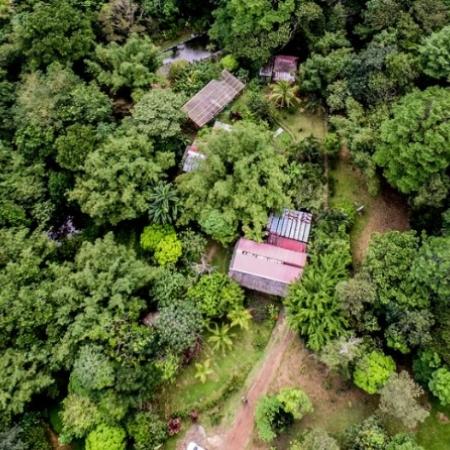
Twenty years ago Nathan Gray, founder of the groundbreaking Earth Train/Geoversity peer-to-peer student activism movement in the United States, was looking for a new headquarters. A friend told him that Panama was a country with a lot of land in need of protection and a lot of young people in need of empowerment. So Nathan began his journey and met several indigenous and mestizo people who recommended Madroño for land purchase.
When Nathan arrived in the valley, a Panamanian woman mentioned that her family was selling a property nearby. Nathan visited the property that same day and soon became the owner of 80 hectares and Geoversity's Mamoní Valley Reserve was born. A nature reserve, an environmental education center, a research-conservation center and a place of transformative experiences.
Like much of the land in the area, the property had been cleared for cattle grazing, so Nathan, a growing Panamanian Earth Train team and a group of volunteers began reforesting the 198 acres (80 hectares) with native plants and trees. Soon the streams were cleared and the wildlife returned. Today we have almost 5,000 acres.
Bamboo was planted, which quickly began to provide building materials for a true nature and environmental education center where Nathan's dreams of educating and training young people to lead other young people to a better environmental future could become a reality.
The Mamoni Center now has open-air wooden and bamboo structures, with space to set up tents, bathrooms with showers and toilets. There is also a large kitchen, dining room, satellite internet, gazebo for meetings and conferences. It has a hydroelectric generator and solar panels.

